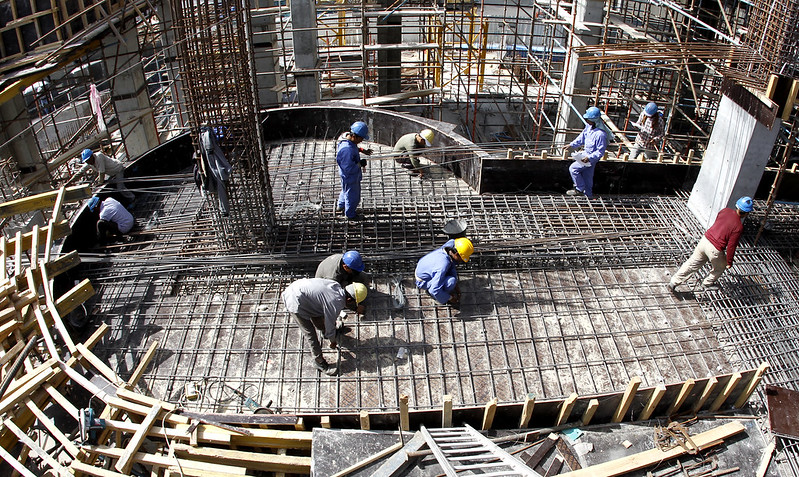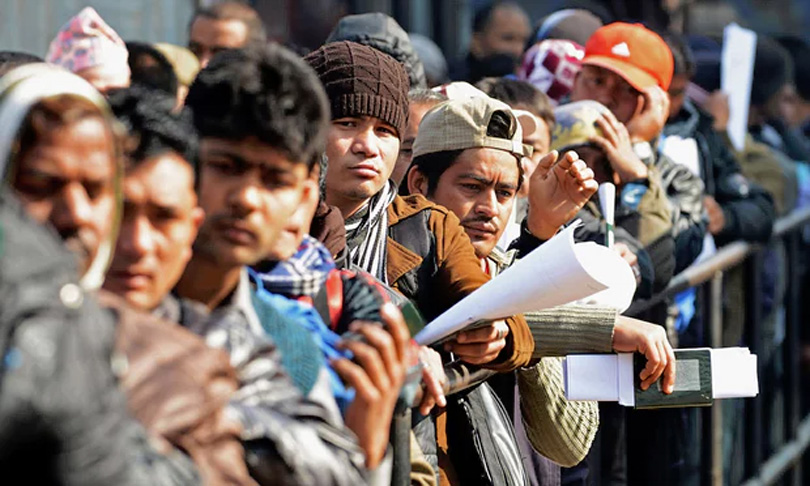
In November, Prem Nepali was on the same plane as delegates headed to Dubai for COP28. But while they shared an aircraft, their reasons to be in Dubai were entirely different. The dignitaries were travelling to negotiate climate change mitigation with world leaders, whereas Prem was leaving his home because the climate has already changed too much.
Prem is from Bardiya district in midwestern Nepal’s Lumbini province, where communities have long faced drawn-out droughts during the monsoon and winter seasons, and heavy rains at harvest time.
Prem is one of thousands of Nepali economic migrants who find employment in the Gulf. “My daughter was just a one-year-old baby when I came here [to the UAE] for the first time. She is 11 now,” says the 34-year-old. Initially, Prem worked as a cleaner. Now he works as a helper in a vehicle repair shop in Al Barsha, Dubai.
“I want to stay with my family and find livelihood in agriculture,” continues Prem. “But these days, weather patterns are not in our favour; agriculture is in a declining trend. How can I stay home?”
Though economic migration is a decades-old phenomenon in Nepal, researchers say that in recent years, extreme weather events and climate change-induced disasters are adding to the factors pushing people out of the country.
“The reasons [for Nepalis] to go to foreign countries are socio-economic conditions and a lack of employment opportunities here in Nepal,” says Amina Maharjan, a migration specialist at the International Centre for Integrated Mountain Development. “Lately, however, we are seeing people choose labour or educational migration as an adaptive measure to post-disaster economic burdens.”
Maharjan’s conclusions are mirrored by a 2023 report by Equidem, a human rights and labour rights non-profit: “Migrant workers interviewed by Equidem migrated for employment to the UAE from the Philippines, Mozambique, Bangladesh, Pakistan, and Nepal – five of the ten countries most affected by climate change between 2000 and 2019.”
The climate factor

Sunder Pandit, 26, now lives in Sydney, Australia. But he often wonders where he would be today if the massive flash flood on Nepal’s Melamchi River had not occurred in June 2021. The disaster claimed at least 17 lives and swept away infrastructure and hundreds of houses.
“That flood pushed me to choose migration in the name of education, but it is not what I wanted or dreamed of,” says Pandit. “The flood swept away our newly established hospitality business and trout farm, where we had invested around Rs 8 million [USD 60,300] by taking loans.”
The Melamchi flood originated in eastern Nepal’s rural Helambu region, where scores of homes were destroyed. One of them belonged to Pandit and his family.
Pandit was fresh out of college, where he studied hospitality management. He had finished an internship in China and was working in a Nepali tourism hotspot, the city of Pokhara, to gain experience. He then returned home to the Sindhupalchok municipality where he launched the Helambu Riverside Resort with his brother, in their village of Chanaute.
“Everything was going great; we were using local products, and the fish farm was also there,” Pandit says. “Within a year, our business took off and already provided employment to 12 locals. But at a time when we were planning to go big, the flood hit hard, and I ended up here.”
In 2021, the environment department published its latest vulnerability and risk assessment. It categorises Sindhupalchok as a “high-impact” area when it comes to climate-induced disasters, while reports suggest the 2021 Melamchi flood was climate-induced. “The Melamchi flood pushed us out from our village,” Pandit says.
Thirty five migrant workers were interviewed by The Third Pole for this report. One of them is 50-year-old Ram Bindo Yadav, who was waiting for a bus from Kathmandu’s main airport to his village in Siraha district on a late January afternoon. He used to farm on rented land, “but in recent years, farming became difficult; there is no irrigation, and we don’t get rainfall when it is needed.”
Ram Bindo was returning from Qatar and one of many migrant workers catching a bus home. Bhuran Yadav, 43, came forward to share his story: “My family’s livelihood depends on agriculture. Uncertain rainfall and frequent droughts in the monsoon season and winter are some of the main reasons I went to Qatar.”
Bhuran Yadav’s village is in south-eastern Nepal’s Shahidnagar municipality, Dhanusha district, where most depend on agriculture. “Because of this, almost every household has at least one member in a Gulf country,” he adds.
Dhanusha and Siraha are both highly vulnerable when it comes to climate-induced disasters. They are situated in the Tarai plains that run between the Himalayas and Nepal’s southern border, which are witnessing back-to-back droughts. And at other times, prolonged, unseasonal rains are destroying harvests.
From farm to foreign land

According to the environment department’s aforementioned 2021 vulnerability and risk assessment, natural hazards (mainly floods and landslides) are one of the major driving forces behind economic migration in Nepal: “The majority of the labour force depends on agriculture and this sector is badly impacted by recurrent floods, droughts, and landslides. As a result, the agricultural labour force, particularly the young, tends to move away from the agriculture sector and explore employment opportunities in the service sector and labour market outside of the country.”
We spoke to the migration researcher and National Network for Safe Migration president, Chiranjivi Baral. He agrees that – alongside other socioeconomic factors – climate change-induced disasters are forcing people to choose labour migration.
“We were talking with sheep herders in Mustang [in northern Nepal], and they said their friends are in the Gulf who used to work in pastureland,” Baral recalls. “According to them, the reason was the impact of not having enough snow and rain.”
Most farmers, from the mountains to the southern plains of Terai, are experiencing the impacts of a changing climate in their day-to-day lives. Findings from the 2021 national agricultural census support this: of the farming families who know about climate change, 91 per cent said it impacted their agricultural activities, of which 85% said it decreased their yields.
But Prem from Bardiya still wishes to return home to make his living. “Farming is what we did as a source of livelihood there, and I have hope that there will be a way to make it happen again, because I want to spend time seeing my daughter grow,” he says, on the phone from Dubai.
This story first appeared on The Third Pole and Onlinekhabar is republishing it under the Creative Commons licence.

























